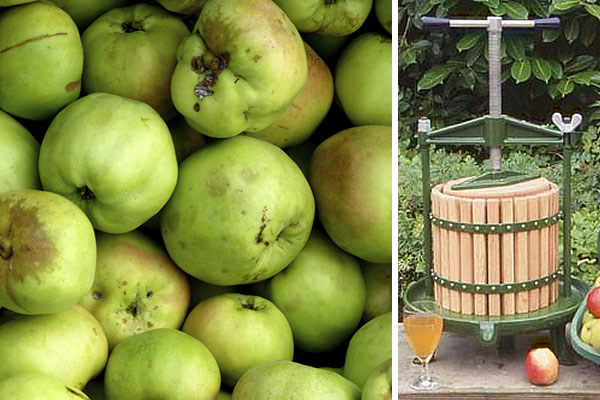Cider making

Kent produces tons of apples and with this abundance of the fruit makes cider making easy to do
Making traditional cider is easy to do and quite cheap to do once you have invested in a Cider Press and some basic brewing equipment.
Cider making starts with the picking the apples, most apples are suitable, but best results are had from those varieties grown specifically for the job. Once picked, the apples are left to mature for about a week before being tipped into a ‘scratcher’ to mash them. The pulp is pressed using a cider press and then fermented. The resulting traditional cider is served flat and clear or cloudy.
Follow the steps explain how to make your own traditional cider.
Making homemade cider
Step 1: Preparing the apples
Pick or purchase your apples when fully ripe, preferably windfalls. Try to avoid heavily bruised or damaged apples, although it’s quite simple to cut out any unwanted parts of the apple. Keep the apples in a cool place for 1-2 weeks to soften the apple skins. If you want your cider to be fermented with wild yeasts make sure you DO NOT wash or sterilise your apples at all.
Step 2: Pressing the apples
Having matured your apples the next step is to press them. You can pres apples with a domestic fruit juicer, but thi will take a lot of time for the quantities required, and the juice yield is low compared to an Apple Press. At the cheaper end of the market arepressed steel presses, but a better option is a wrought iron and beach Apple Press – the sturdier the better.
Step 3: Getting the balance right
Once the juice is separated from the pulp check the pH which should be in the range 3.9 to 4.0. To lower the pH add malic acid or to raise the pH add precipitated chalk.
For clear cider add 1 tsp of pectolase per gallon of juice. For cloudy traditional ciders just leave as is. Both Ciders will taste the same regardless.
Depending on the apples you started with, you may need to compensate for a lack of sweet apples. Measure the OG (Original Gravity) which should be around 1055. Add sugar if you need to bring it to this level. A good guide to how much to add is 2 1/2 ounces of sugar will raise the gravity of 1 gallon of juice by approximately 5 degrees. You can either dissolve the sugar in a small quantity of juice and add to the bulk of the juice, or if caster sugar is used, stir it directly into the bulk of the juice.
Never heat the juice otherwise you will get a cooked apple flavour and ruined cider.
Step 4: Fermenting the apple juice
Place the apple juice in a fermenting container. Traditionally this is a wooden barrel but a plastic barrel will do the job. The type ued for wine making are ideal. Put under an airlock and leave to ferment.
Cider is traditionally fermented at whatever is the outside ambient temperature, however, if you are fermenting with a pure yeast culture it may be better to ferment at the temperature specified with the culture. There are wild yeasts present on apple skins (so long as they are from an unsprayed orchard) which will ferment the cider naturally. If you wish to ferment with a specific yeast, add 1 crushed campden tablet per gallon of juice and leave to stand, covered, for 48 hours. This will see off the wild yeast. Then pitch with a yeast of your choice.
For a traditional style English cider, use an ale-type yeast.
For a Normandy style cider use a wine yeast. Kitzinger, Hock, and Champagne yeasts all give good results. The finished product is paler than English cider and tastes closer to apple wine than does English cider.
Check the gravity regularly. There is a tendency to go on fermenting after the desired gravity has been obtained. To prevent this, you can add a crushed campden tablet to the cider when the desired gravity is reached.
Step 5: Storing the cider
Once the desired gravity is obtained, the cider is ready to mature. Store the cider in glass carboys or other similar container, under airlock. Cider is usually left in outbuildings to mature. The fluctuations in temperature are not detrimental.
In the late spring or early summer following the making of the cider, it will undergo a malo-lactic fermentation. This will occur when the temperature reaches approximately 15 C. This has the effect of mellowing the cider, it will lose much of its sharpness. You can add malic acid or acid blend at this point if the cider is not sharp enough for your taste. Traditional English cider is flat, no attempt is made at a secondary fermentation.
English cider may also be served slightly carbonated analogous to real ale. The target carbonation in this case is 1 volume of carbon dioxide per volume of cider (partial pressure of carbon dioxide of 1 atmosphere). If the cider is to be served slightly carbonated, bottle in beer bottles with 1/2 teaspoon of sugar per pint of cider (dissolve the sugar in water and add to the cider before bottling).
Normandy cider is refermented in Champagne-style bottle in a manner similar to Champagne making and is highly carbonated.
Step 6: The final step
Pour into glass and enjoy!
Resources
Local Kent producers include:
- A.Riccini + Sons (closed)
- Biddenden Vineyards Ltd
- Brogdale Horticultural Trust
- Kent Cider Co.
- Castle Cider Co.
- Chafford Cider
- Double Vision Cider Co.
- Mount Ephraim Gardens
- Owlet Cider
- Pawley Farm Cider
- Pippin Cider
- Pippins Cider Co.
- Sepham Farm
- The Windmill
Visit CAMRA or Kentish Fare for more information.
